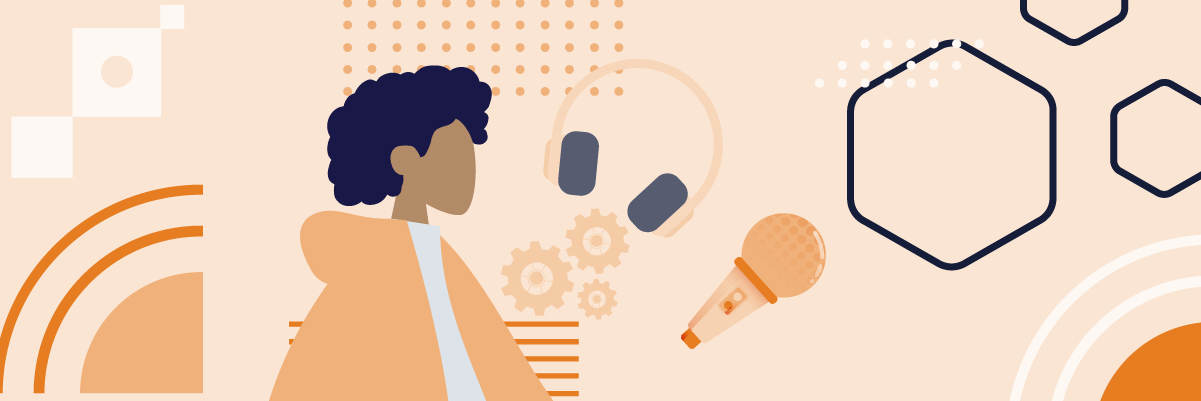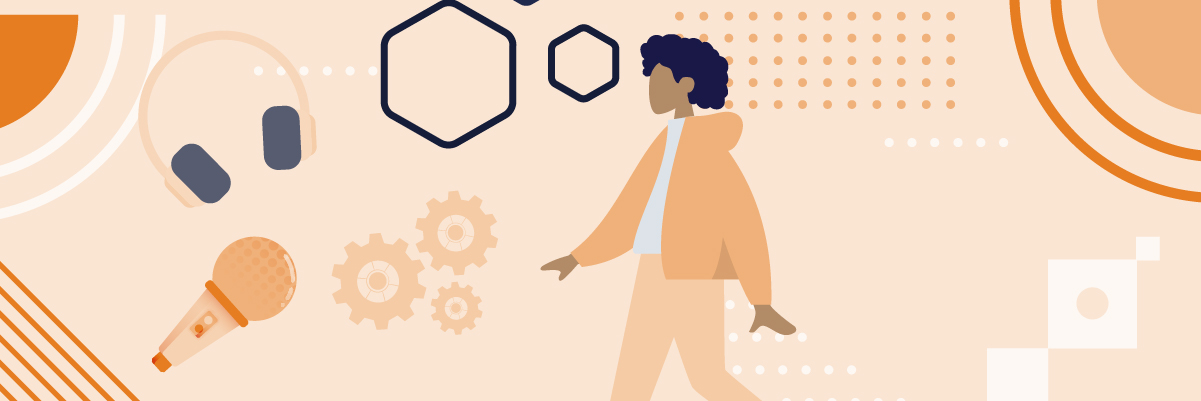You’ve heard of 3D audio, and perhaps 8D audio as well – but what exactly is 16D audio?
Well, if you are expecting something completely different, we are sorry to disappoint.
If there is any difference between 3D, 8D, and 16D audio, it lies in the technique used to manipulate the sound.
At the basis of it, creating multi-dimensional sound involves panning audio tracks from left to right with reverb so it sounds like it’s going in a circle.
And this practice is anything but new.
Read on to find out more about 16D audio and how to create it.
Brief Lessons on 16D Audio
Before we go further, you should know that there is no such thing as 16D audio…or 3D audio…or 8D audio.
These terminologies don’t really mean anything, and here is why:
Let’s break it down, shall we?
Mono Vs Stereo Sound
In the Mono audio format, also called single-channel audio, all the audio travels through one channel.
Here’s an example to better understand it:
When listening to music using headphones, you may have noticed that sometimes, the vocals and beats play distinctly on each side of the speaker.
In Mono audio, there is no way to separate the vocals from the beats because all the audio goes through one channel.
Stereo sound has two audio channels that allow sound to be split or localized to the left or right.
Note that stereo sound does not allow sound to be localized all around a listener – just to the left or right.
Stereo sound, therefore, aims to acknowledge all the different sources of sound and create space for what is important.
A lot of music is recorded for stereo, so anything more than 2D sound implies an alteration of the original audio.
But we exist in a three-dimensional space, so how can audio have anything more than 3 dimensions?
Well, these are virtual channels that are positioned differently within a three-dimensional space.
The higher the sound dimension, the greater the alteration.
Some listeners find the results better and even compare it to listening to a live performance. Other listeners consider these alterations to be degradations to the original sound quality.
It’s all about personal taste at the end of the day.
Everything you need to know about making 3D audio.
Making 16D Audio
Creating multi-dimensional sound involves introducing a slight delay to the audio.
The difference between all these sounds lies in the technique used to create them:
3D audio exists when two separate audio tracks are panned from left to right. One can argue that all the other alterations are just slight improvements of 3D audio. This is the most popular format and some brands even adopt 3D audio commercials as a marketing strategy.
Creating 8D audio involves a technique called binaural panning. Two separate tracks are panned from left to right with an added reverb – making the audio seem like it’s coming from multiple sources all around the listener.
16D audio involves panning separate tracks independently from left to right using binaural panning. In 16D audio, the vocals and backing music and panned separately.
The Real Multi-Dimensional Sound
So it goes on and on…
A quick Google search will reveal all kinds of audio dimensions. From 2D all the way to 1000D audio.
Now comes the interesting part:
A deeper search reveals that none of these audio dimensions are in fact real. They are all just gimmicks and have no real difference.
But the internet keeps giving.
The question then changes from ‘what is 16D audio’ to ‘what is multi-dimensional sound and is it real?’
Where does it Stop?
Have you heard about surround sound?
That’s when you use several stereo channels (the most common standard is 5.1 channel) to create the illusion that sound exists all around you.
The basic arrangement involves a set of front speakers on the left and right, a center speaker between them, and an accompanying set of surround speakers behind the listener.
Surround-sound is designed to immerse the listener in audio from all angles, all sides, and all heights.
This revolutionary technique was inspired by Dolby’s Atmos technology.
Imagine watching an action-packed movie in the theater, and there is a loud bang on the left side. Without surround sound, all the speakers would play the same sound.
With surround sound, the audio would come from the left.
These ‘dimensional audios’ are all just attempts to make stereo audio have the same effect as surround sound. With 16D audio, the is that the listener will feel the sound coming from 16 distinct directions.
Multi-dimensional Audio vs Surround-sound
Why not make a surround sound system with eight, sixteen, or as many channels as one needs?
Well, because a lot of audio is made for stereo and Atmos technology only allows for up to 64 different speakers.
So while you can get 5.1, 7.1, and even 11 channel surround sound speakers, it might be more expensive.
Besides, mixing audio for as many as 16 distinct destinations is hard. You have to consider amplification, speaker placement, and cabling.
Electronic manipulation of audio is easier – the creator adds artificial echoes to the audio and processes the sound to make the listener think that it is coming from another direction.
This is why:
You cannot hear multi-dimensional sound on loudspeakers – so please wear headphones for this experience.
Stereo sound travels on two channels. Surround sound travels on 5 or seven channels. Spatial sound exists all around you, but there is no technology that allows it exist in an artificial space. Electronically manipulating the audio using panning and equalization techniques creates the illusion of spatial audio, and the only way to listen is with headphones.
Benefits of spatial audio for businesses.
Altering a sound to create 16D audio will not necessarily improve the quality of the audio. It may actually worsen it, making the love of 16D audio subjective.

Where to Use 16D Sound
We can only listen with two ears because that’s all we have, but multi-dimensional sound tricks the brain into thinking there is more space than there actually is.
In as much as the alterations are major, audio doesn’t become clearer or louder because of multi-dimensional effects.
As a listener, you may or may not notice the difference between regular and multi-dimensional sound.
The idea is to make it seem like the music is constantly moving around you.
A lot of people find that music sounds better in mono. Listening to stereo also sounds natural as we have two ears.
However, 16D audio is perfect for movies for this reason:
With 16D audio, objects sound where they should be based on the action on the screen.
Binaural panning is also used in video games to make the players feel like they are existing within that space.
It’s the illusion of surround sound that draws people to multi-dimensional audio, even though it is not real.
What Does 16D Audio Sound Like?
You can remaster any song or genre into 16D audio. However, more ambient songs lend themselves best to this technique.
It can create an encapsulating and eerie listening environment. Listening to 16D audio creates a virtual bubble in your headphones, and may even allow for better concentration.
Some listeners have complained that the sound moves too fast and is distracting, but this points more to the creator’s fault.
The effect of multi-dimensional audio is psychological and changes depending on who is listening.
Some listeners have gone as far as comparing the experience of 16D audio to getting high or a feeling of weightlessness.
You can find 16D audio versions of your favorite songs on YouTube.
FAQs About 16D Audio
Although the idea behind multi-dimensional audio remains the same, the names keep changing. It’s understandable that you may have some confusion concerning 16D audio (or any other multi-dimensional audio).
We address all the questions and concerns here:
Can 16D audio make you sick?
Not, it is safe to listen to 16D audio. However, if mixed poorly, multi-dimensional audio can make you feel dizzy or nauseous.
It can even sound distracting is the creator pans the sound too fast.
Is 16D audio dangerous?
All sound is dangerous if you play it too loud. The appropriate listening level is around 85dB, although this may differ depending on the listener.
Listening to 16D audio at a normal volume is not dangerous.
Does 16D audio only work on headphones?
Yes, and this is a big reason why critics consider 16D audio to be a gimmick. Chances are that it will never work without using headphones.
It’s like listening with your brain and not your ears as you feel the sound all around you – almost like you are surrounded by a virtual bubble.
This leads to another question;
Can you listen to 16D audio in the car?
Well, there are stereo speakers involved, but the perpetual movement of the sound might be lost without headphones.
Stereo sound travels on two channels. Surround sound travels on 5 or seven channels. Spatial sound exists all around you, but there is no technology that allows it to exist in an artificial space. Electronically manipulating the audio using panning and equalization techniques creates the illusion of spatial audio, and the only way to listen is with headphones.
Ready to Experience 16D Audio?
Everybody on music streaming platforms wants to get on the 16D audio train. Manipulating the various parts of a stereo track to create the illusion of more space is not a new thing.
Here is what we have to say about it:
It’s a preference.
If 16D audio makes you feel like you are at the front of a live concert, well and good. If it makes you feel like you are about to pull your ears out, stay away from it.
These audio manipulation techniques are nothing new, but they might be here to stay so buckle up and have some fun with it.
Get started today! Work with the best audio experts in the industry.










